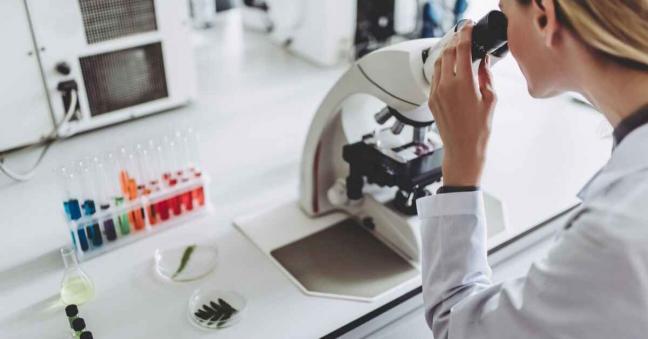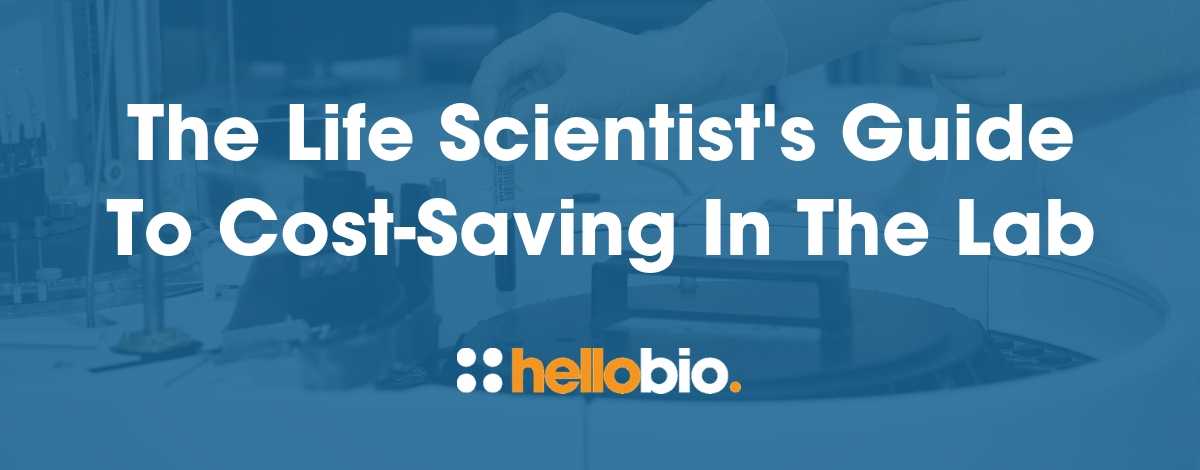10 Tips to Create More Efficiency in the Lab
“Work smarter, not harder.” It just sounds like a cliché, right? However it’s a vital tenet for the effective labs of today and of the future. Put simply, being smart and efficient means you’ll end up having more time and more money to do better research and get your lab to have a true societal impact faster! We think everyone can agree with that.
Starting your career in science often comes with a tremendous list of things you need to do: reading, writing, performing experiments, presenting your work and communicating it to the public. Creating lab efficiency will help you keep ticking off items from the seemingly never ending list in the fastest possible way. If you can keep the rate of rise of your to-do list linear (as opposed to exponential) then you’re doing a great job!
Just finishing my first year of my PhD, I tried to implement a few tactics to successfully get my work done in a timely manner. The following tips are the ones that I have learned during my short career in science so far. I work at the cutting-edge of therapeutic G protein-coupled receptor biology, but I think my suggestions have the capacity to help a broad range of biomedical scientists.
1. Plan your work in advance
For me the easiest way of increasing lab efficiency is planning ahead. Making a color-coded daily, itemized to-do list, or a weekly schedule, will allow you to have a visual overview – and it’s really satisfying when ticking off completed tasks! By having a clear overview of things you need to do, you’ll make sure that you don’t forget some small tasks and you can use your time more effectively. Planning your day in writing instead of in your mind makes your brain free to think about more important things, i.e. your experiments and future theoretical perspectives for your lab.
2. Organize your workspace
The next important step is organizing your workspace, think of it as ‘Biomedical Feng Shui’. This will make your work experience much more pleasant, less error-prone and more time-efficient. It’s so easy to feel inspired and happy in a well-kept and thoughtfully organized workspace.
What’s more, being proud of your creative workspace is a wonderful way to help keep you going when things get tough in the lab! Keep your frequently used pipets, tweezers, scrapers and other tools within arm’s reach. If it’s possible, put them at the side of your dominant hand. Have a rack with all the necessary solutions for each experiment within reach too, in an orderly manner. By doing so, you won’t need to search for the right solutions every time you need them.
Also, keep your workspace clean after each experiment. You don’t necessarily need to do it right away, but at least make sure you do it before the end of the day. Then, preparing and setting things out for your work the following day can really improve the start to it. It will mean one less chore to do before you can get down to work. Think of yourself being a conductor of your lab ‘orchestra’: without order, connectivity and communication you can’t make beautiful music / science with your instruments.
3. Enhance your stock control
In addition to keeping your workspace organized, you will really help yourself and your lab members by organizing and augmenting your stock reagents / materials control. The only thing worse than not being able to find something is finding out that you are out of stock. Every lab should try and create a system (that everyone buys into) in which you can easily check which materials are available and then can be swiftly notified when something is starting to run out (e.g. at 10% of total capacity limit) or has totally run out. This is certainly not something you need to do alone, every person in the lab has the ability to play a larger role for the team. In our laboratory we came up with a rotation system. Every week, someone else has to take care of the stock control using a spreadsheet with all the materials and their catalogue number for ordering. This makes it really convenient next time you need to order something, and it helped us keep better track of materials. And in turn, productivity will increase.
4. Write everything down (in detail!)
Hat-tip to Adam Savage for this: "Remember kids, the only difference between screwing around and science is writing it down." It is impossible to remember everything, therefore keeping a lab journal is super important. You can either have a digital one (ELN) or a hard cover. I prefer to use a hard cover, since you can easily carry it everywhere (except home of course!)
Use your lab book to write down every step of your protocol in detail and highlight the things that you did wrong or if things have changed. This helps you to explain weird results later on, as you can go back and go over the notes and then think to yourself: “Aha!, that’s what went wrong!” or “That’s when we changed the vendor for our BSA and that’s why our blots have changed.” Not to mention, you have a record of everything you do so no one can question your productivity – and more importantly, you appreciate how much you’ve done to get your hard-earned results! Lastly make sure you make a table of contents to easily find the results of your experiments if you need to perform a novel form of correlation.
5. Standardize your working habits
While this might seem a bit too obsessive, I really think good habits will result in better productivity. One example that everyone does here in the lab is labeling their tubes with a different color coding depending on the buffer used. This allows you to have a quick overview of your samples. Another way of standardizing my workflow is by changing the place of the sample if I’ve done the next step in the protocol. Then if someone interrupts you, you know which sample you already processed and which sample you still need to do.
6. Label EVERYTHING!
This one seems pretty basic, however I’m often surprised that people forget to label or insufficiently label their stuff. Always write down the date it was made, the experiment or what is in it, and your name. Not only should your samples be labeled, but also all the aliquots of buffers you make should be labeled and potentially dated. This can increase your efficiency tremendously, reduce errors, and improve accuracy.
7. Make sure everyone knows everything
Good training and coordination of all your employees is essential to helping them achieve their best levels of productivity. Having a strong understanding of both the technical and theoretical components of your research supports your confidence and therefore leads to reduced errors, reduces the need to keep on replicating experiments, and results in increased productivity.
Try to make sure that everyone knows everything they need to know to perform and troubleshoot the experiment they’re undertaking, or knows where to find the best answers and from whom. Having this network capacity in the lab also significantly augments productivity as if one lab member is sick, your lab can continue to run as each member of the team can then take over that task and fill in.
Something that we implemented in our laboratory was labeling every buffer with a protocol of how to make it. In addition to this, we make a network folder available for everyone containing our protocols as well as videos that we have made that make a visual record of our more complex tasks (we started doing this before YouTube became the go to place for protocols).
8. Communicate
As they say: “Communication is the key to success.” Think back to when you gave someone instructions and they were not clear. This probably resulted in a waste of time, effort and resources. If you give someone instructions, be as clear as possible (also with written backup) and provide them with everything they may need to carry out that experiment. Furthermore, honest and effective communication will create a stronger, more connected and spirited team. If lab members consult each other with their obstacles and listen to each other’s opinions, they will create a more enjoyable workplace, leading to better performance and productivity. As we all know:“Team work makes the dream work!”
9. Take strategic breaks
Working long hours might seem the best thing to do and it may feel like you have been productive. However, your productivity and attention-span decreases over time. Allow yourself to take a small ‘micro-break’ from time to time. This break doesn’t need to be long, just enough to clear your mind. Going for a quick coffee or a short walk can be more than enough, but make sure you don’t interrupt your colleagues. By doing this you will get the most out of your day at work.
10. Templates here and templates there
Lastly, try to use as many templates as possible. If you routinely perform protein quantification experiments, it is a good idea to have a template to calculate the right concentration. That way you can just insert the correct information and then paste it in your lab book. Also for running western blots you can easily generate a template. In a year from now, you will still know exactly how you loaded your gel and what antibodies you tested.
So, as a parting message, science is tough and a long road. It’s super-important to ‘keep your eyes on the prize.’ Try and think every day how the small, seemingly insignificant little task you are performing will, in the future, form a vital piece of the eventual puzzle that could help someone with a terrible disease. If you realize how important the little details are each day, after a few years you will have reached your goal a lot faster as you toiled over the details to make a beautiful picture. In short, try and mold your attitude to one that is laser-focused on the big goal! For yourself and for society, we all want to reach the ‘prize’ as quickly and as efficiently as possible. As a proud Belgian drug discovery scientist I always think of Dr. Paul Janssens (Janssens Pharmaceutica) and his famous phrase: “patients are waiting.” Being efficient with our science could be life-saving!
_________________________________________________
Hanne Leyson obtained her Master’s degree in Biochemistry and Biotechnology from the University of Antwerp (BE) with great distinction. During her studies, she was selected for the prestigious UAntwerp Honors College program. After graduation, Hanne started her doctoral studies in the Receptor Biology Lab of Professor Stuart Maudsley. She was also an undergraduate student representative on the Biochemistry/Biotechnology Education Commission and the Faculty Board. During her first year as a PhD student, she was able to contribute to six papers.
You can connect with Hanne on twitter at @LeysenHanne, and on LinkedIn here.
Find out more about Hanne’s work at the links below:
- https://www.uantwerpen.be/en/staff/stuart-maudsley...
- https://www.facebook.com/MaudsleyLab
- https://twitter.com/stuartmaudsley
- https://www.instagram.com/receptorbiologylab/?hl=e...
- https://www.researchgate.net/profile/Stuart_Maudsley
_________________________________________________
If you enjoyed reading this article, why not check out the other resources available on our blog. We are passionate about supporting early career life scientists and PhD students - with affordable reagents and biochemicals, travel grants, and resources to help with both personal and professional development. We know how tough it is - so we hope you find these helpful!
Advice & guidance for life scientists
Click below to view our of essential guides and articles includes to support life scientists, PhD students & early career life scientists:
Travel grants
Every month we give away $500 to PhD students and Postdocs so that they can attend a scientific conference - click below to find out more:
Wellbeing for scientists
Click below for our resources to help improve your wellbeing:
Technical resources
Try our Molarity Calculator: a quick and easy way to calculate the mass, volume or concentration required for making a solution.
Try our Dilution Calculator: an easy way to work out how to dilute stock solutions of known concentrations
Click below to see our Mini-reviews, Pathway Posters & Product Guides: a set of technical resources to answer your questions on a wide range of topics and to help you get started quickly.
And - when you get to the stage of planning your experiments, don't forget that we offer a range of agonists, antagonists, inhibitors, activators, antibodies and fluorescent tools at up to half the price of other suppliers - click below to see how we compare with other suppliers:














